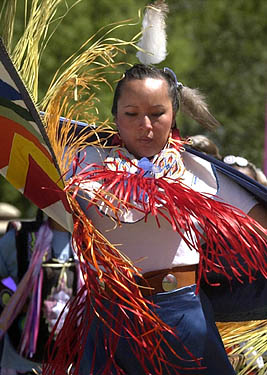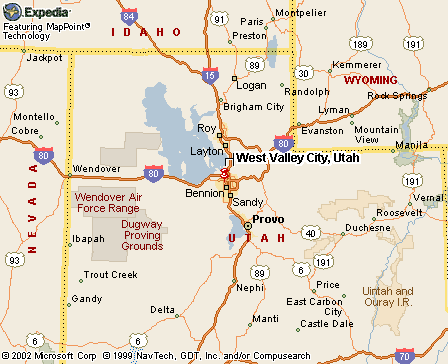|
|
Canku Ota |
|
|
(Many Paths) |
||
|
An Online Newsletter Celebrating Native America |
||
|
September 7, 2002 - Issue 69 |
||
|
|
||
|
Dance and Song at WVC Festival Belie Educational Challenges Facing Indians |
||
|
by Tim Sullivan Salt
LakeTribune
|
||
|
|
|
"They have their own destiny, and they
are tested to grow up to be adults and then grandfathers and grandmothers.
It's a full circle." Shepherd, a Paiute-Navajo, came over 300 miles
from St. George to participate in West Valley City's Native American
Festival and Powwow, which ran Friday through Sunday and, apart from
nearly constant dancing, featured food, craft booths and traditional
singing. The theme of this year's powwow was "Empowering
Our Youth," and while many admired the colorful outfits, dancing
and the proficiency of youngsters in executing traditional songs inside
the circle, just as important, said Shepherd, are the challenges outside
it. Belying the harmony at the powwow is a fractured
picture of American Indian education in Utah. According to newly released
figures from the U.S. Census Bureau, 68.7 percent of Utah's American
Indians have graduated from high school, as compared with 87.7 percent
for the state's overall population. The Ute Education Department, meanwhile, said
about 80 percent of students from the Uintah and Ouray Reservation in
eastern Utah do not finish high school. It is a concern to American Indian leaders
and parents alike, because, said Shepherd, "without education,
you're not going to get anywhere. Nowadays you need that diploma."
The educational despair also is at odds with
the cohesion and pride fostered at festivals such as this weekend's
powwow, and even rank-and-file tribal members differ in their approaches
to solving such problems. A good start, said Shepherd, is schooling
American Indian kids with everyone else. The five small bands of Paiutes
in southwestern Utah largely attend mainstream public schools, and he
said he prefers it that way. "There should be cross-cultural diversity,"
he said. "You need to learn both ways." But some tribes are too large and remote to
bus to white schools. The Navajo Reservation, for example, with a larger
land area than Rhode Island, has several schools that Navajo tribal
member Emerson Bill said suffer from a lack of funds. Bill said the
most critical needs for reservation schools, in Southeast Utah, Northern
Arizona and western New Mexico are better-paid teachers, better facilities
and more computers. Bill's son Emberson, sitting with his father
around a giant drum, agreed, saying he felt that his education at East
High School in Salt Lake City was better than that received by his relatives
on the reservation. But Ira Waterhouse of the Northern Shoshone
tribe, wearing a green costume flecked with feathers and bells at the
ankles, said it is also important for reservation schools to concentrate
on including tradition. Waterhouse said formal education at Idaho's
Fort Hall Reservation where he lives often veers away from the traditions
he believes are important for young Shoshones to learn. As a result,
said Waterhouse, parents end up with a bigger burden to teach their
children traditions such as dancing, singing and perhaps most importantly,
language. Waterhouse said he has to speak the Shoshone
language in his family's home "constantly" for his children
to retain it. More American Indian teachers in schools teaching American
Indian traditions, he said, would take the pressure off parents and
give kids on the reservation a more well-rounded education. Harry James, a Navajo and an organizer of
the powwow, also said language should be a high priority for American
Indian education. "They need to learn to speak both languages,"
James said. "We need to keep language alive, to let them know who
they are." James' son Drew, meanwhile, said drug and
alcohol abuse and gang violence are more immediate problems threatening
American Indian kids, and also should be addressed in schools. Drew
James said schools should hire American Indian counselors to talk to
at-risk youth about these problems, preferably mentors who are former
addicts, alcoholics or gang members and have turned their lives around.
American Indian kids, he said, need these examples. And if that doesn't work, Drew James proposes
another solution -- traditional dancing. "It's a nice hobby to have," he said, his face etching a smile in his white face paint. "It kept me out of trouble.''
|
|
|
||
|
|
||
| Canku Ota is a free Newsletter celebrating Native America, its traditions and accomplishments . We do not provide subscriber or visitor names to anyone. Some articles presented in Canku Ota may contain copyright material. We have received appropriate permissions for republishing any articles. Material appearing here is distributed without profit or monetary gain to those who have expressed an interest. This is in accordance with Title 17 U.S.C. section 107. | ||
|
Canku Ota is a copyright © 2000, 2001, 2002 of Vicki Lockard and Paul Barry. |
||
 |
 |
|
|
The "Canku Ota - A Newsletter Celebrating Native America" web site and its design is the |
||
|
Copyright © 1999, 2000, 2001, 2002 of Paul C. Barry. |
||
|
All Rights Reserved. |
||
 "The
circle is a way of life," said Alex O. Shepherd, nodding toward
a group of children, some in lavish costume, others in street clothes,
all of them dancing in the ring formed by tents in the middle of Granger
Park.
"The
circle is a way of life," said Alex O. Shepherd, nodding toward
a group of children, some in lavish costume, others in street clothes,
all of them dancing in the ring formed by tents in the middle of Granger
Park. 